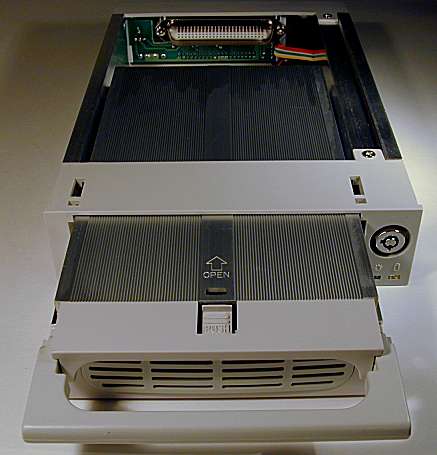[ The PC Guide | Systems and Components Reference Guide | Hard Disk Drives | Construction and Operation of the Hard Disk | Hard Disk Form Factors ]
Removable Hard Disk Trays
An interesting compromise between internal and external hard disks is the removable hard disk drive tray. A tray is installed into a standard PC case drive bay that allows regular internal hard disks to be placed into it. You then can swap the internal hard disk with another one without opening up the case, allowing you to use hard disks as a removable storage medium. In a way, the concept is similar to the way a removable car stereo is designed. These trays are also commonly called mobile racks, drive caddies and several other names.
|
Shown above is the Kingwin KF-21-IPF mobile rack system
that I use on my |
For certain applications, this are the ideal removable storage device: it uses regular hard disks, which are very fast, highly reliable, very high capacity and very inexpensive in terms of dollars per byte of storage. They can be used for backup purposes (secondary to a regularly-installed standard internal hard disk)--see here for more information on this idea. Removable trays can also be used to allow the use of different operating systems on the same PC (though there are simpler ways to do this) and to allow different people to use the same PC while keeping their data and programs totally separate.
If you decide to use a mobile rack system, be sure to check out the specifications of the unit you are considering carefully. Different models come with support for different speed drives, some are made primarily of metal and others of plastic, and so on. Metal units will provide better cooling than plastic ones. Some also come with an integrated cooling fan, which is a good idea especially for higher-RPM drives.
![]() Warning: If you decide to
set up this sort of arrangement with your PC, remember that regular internal hard drives
are designed under the assumption that they will be installed inside the PC and left
there. Be sure to handle them properly, and especially, to
observe ESD precautions.
Warning: If you decide to
set up this sort of arrangement with your PC, remember that regular internal hard drives
are designed under the assumption that they will be installed inside the PC and left
there. Be sure to handle them properly, and especially, to
observe ESD precautions.
![]() Next: Hard Disk
Packaging and Mounting
Next: Hard Disk
Packaging and Mounting
| The PC Guide
(http://www.PCGuide.com) Site Version: 2.2.0 - Version Date: April 17, 2001 © Copyright 1997-2004 Charles M. Kozierok. All Rights Reserved. |
Not responsible for any loss resulting from the use of this site. Please read the Site Guide before using this material. |
